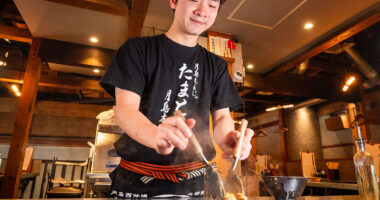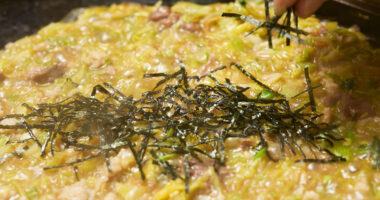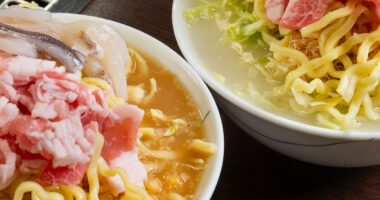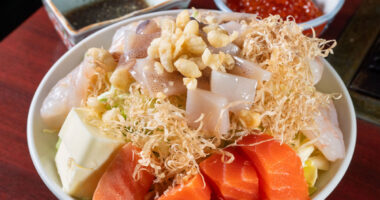Monjayaki is considered a local specialty cuisine of Tokyo.
The Tsukishima area of Tokyo in particular is home to many monjayaki restaurants and is bustling with tourists every day.
Originally created as a children’s snack, monjayaki was quite simple in terms of ingredients. It consisted of flour dissolved in water, seasoned, and then cooked on a griddle.
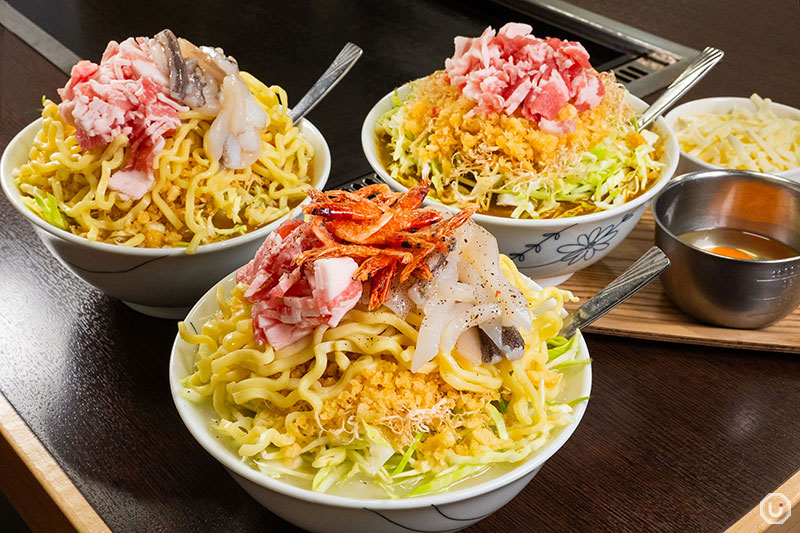
However, as monjayaki gained popularity, both its flavorings and ingredients evolved, becoming more varied and diverse.
It remains an easy, casual dish to enjoy, but as you explore the appeal of monjayaki, you’ll find it’s actually deeper and more complex than it seems!
Introducing the charm and history of monjayaki are two restaurants: “Tamatoya Tsukishima Honten” (hereafter referred to as “Tamatoya”). Both are popular establishments that are emblematic of the Tsukishima area.

(left) Yoshimiya, (right) Tamatoya
What is monjayaki: a local dish developed in Tsukishima
Monjayaki has a long history, tracing back to Japan’s Edo period.
At that time, it wasn’t called “monjayaki” but rather “mojiyaki” (literally “character grilling”) and was popular as a kind of dagashi (cheap nostalgic candy or snacks enjoyed by children).
Mr. Kishi, the manager of Tamatoya, explains the origins of mojiyaki, which is said to be the root of monjayaki.

Mojiyaki involved dissolving udon or wheat flour in water and using the mixture to draw pictures or write characters on a hot griddle. It was flavored with soy sauce or sweet black syrup.
Even as time passed into the Showa era (1926-1989), monjayaki continued to be served at stores specializing in dagashi.
Its origins as a type of dagashi are also one of the reasons Tsukishima became home to so many monjayaki shops.

Tsukishima was originally a neighborhood where many factory workers lived. As the number of workers grew, so did the number of children. With so many kids in the area, many dagashi shops opened, which I believe eventually led to the unique characteristic of today’s Tsukishima—its many monjayaki restaurants.
So just when did monjayaki shift from being a kids’ snack to a widely enjoyed meal for adults?
Mr. Murata, the manager of Yoshimiya, which boasts a long history among the monjayaki restaurants in the Tsukishima area, explains:

There have long been restaurants that serve both okonomiyaki (a Japanese savory pancake-like dish) and monjayaki. I’ve heard that in the past, they focused more on okonomiyaki. From there, I think ingredients and ways of eating gradually increased.
One turning point that made monjayaki more famous than okonomiyaki in the Tsukishima area was the influence of media:

I heard one of the local restaurants in Tsukishima appeared on TV and helped promote monjayaki. That was around the 1980s or 1990s.
The second major turning point in Tsukishima’s transformation into a “monjayaki town” came with the opening of Tsukishima Station.

In the past, walking from Ginza was the only way to get to the Tsukishima area. After Tsukishima Station was built, people began to flow in, and I think the area prospered because of it.
And now, the Tsukishima area has grown to create “Tsukishima Monja Street” (monjayaki is often shortened to monja). More than 50 monjayaki restaurants of all sizes line the approximately 500-meter (550-yard) street.
On weekends, the street becomes as lively as a festival. The star attraction for visitors is, of course, monjayaki.
Not only Japanese people but also visitors from all around the world now come to Tsukishima Monjayaki Street every day in search of monjayaki, Tokyo’s local delicacy.
The difference between monjayaki and okonomiyaki: which should you try?
Monjayaki is often discussed alongside okonomiyaki, a local specialty from Osaka.

Okonomiyaki at Teppan Daikichi
Both monjayaki and okonomiyaki are similar in that they use wheat flour dissolved in water as the batter.
Another common appeal of both monjayaki and okonomiyaki is that they can be customized by combining various ingredients with cabbage as the base.
However, monjayaki has a much higher water content, making the batter quite runny and paste-like compared to okonomiyaki. Okonomiyaki, on the other hand, has a fluffy, more substantial texture similar to a pancake.
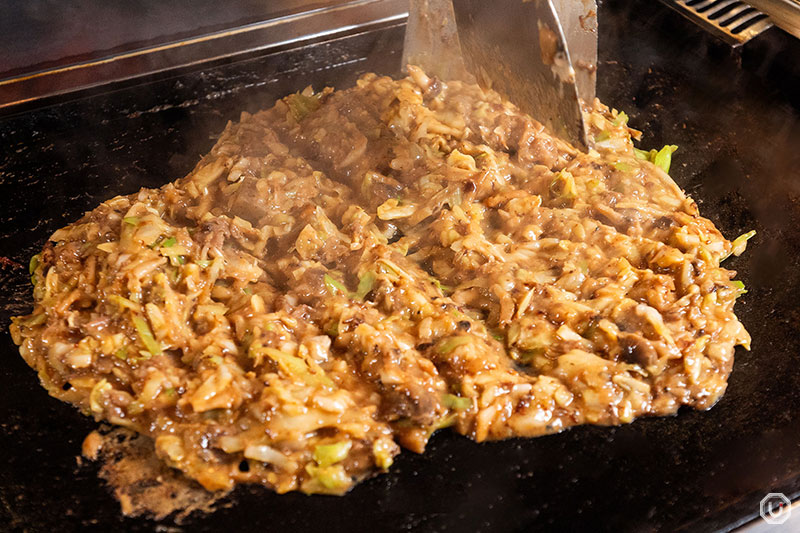
There’s no definitive answer to which is “better,” but when deciding which to try, it might be a good idea to consider your dining situation as one criterion.

Okonomiyaki is topped with sōsu (Japanese brown sauce) and mayonnaise as the finishing touch, so its appeal lies in its robust flavor and satisfying texture. We sometimes recommend it together with monjayaki for customers who enjoy rich, sauce-based flavors or who want to experience a variety of tastes.
If you’re looking for a hearty, filling meal — especially with a group — okonomiyaki is a great choice thanks to its volume.
Monjayaki is also a good option for groups, but at Tamatoya they describe the difference from okonomiyaki as follows:

Monjayaki is a dish where you can enjoy the changing flavors from when you start grilling until you finish eating. If you want to enjoy snacking with drinks while gathered around the griddle, monjayaki might be more suitable.
Monjayaki ingredients: tips for making it at home
One of monjayaki’s charms is its variety. You can mix and match ingredients to create your own flavor combinations
There are no restrictions on ingredients; you can use meat, seafood, or even curry roux—the possibilities are diverse.
That said, there are basic ingredients common to all monjayaki. In other words, if you use the basic ingredients, the rest depends on the cook’s imagination.
The freedom to create your own variations is perhaps monjayaki’s greatest appeal.
- Wheat flour and water: Dissolve wheat flour in water until it reaches a soupy consistency to make the batter. The most common seasoning is sōsu, though soy sauce or salt-based sauces are sometimes used instead. There are also soy or salt-based sauces.
- Cabbage: Shredded or finely chopped.
- Agedama: Also called tenkasu. These are crunchy bits of tempura batter formed during the tempura frying process.
- Cut squid: Surume (dried squid) that has been chopped.
Some shops also use sakura ebi (tiny dried shrimp) as a base ingredient.
When making it at home, you can substitute dried squid or sakura ebi with powdered dashi soup stock. Agedama enhances flavor and adds textural contrast, but isn’t essential for home cooking.
How to cook monjayaki
While okonomiyaki has a simple cooking method where all ingredients are mixed together before grilling on the hot plate, monjayaki is prepared through several steps.
Here’s the general process followed at most monjayaki restaurants:
Step 1: Stir-fry only the main ingredients on an oiled hot plate. During this time, keep the batter in a bowl.

Step 2: Form the stir-fried ingredients into a donut shape.

Step 3: Pour the batter into the hollow space of the donut shape you just made.

Step 4: Mix the ingredients and batter while stir-frying until it becomes paste-like.
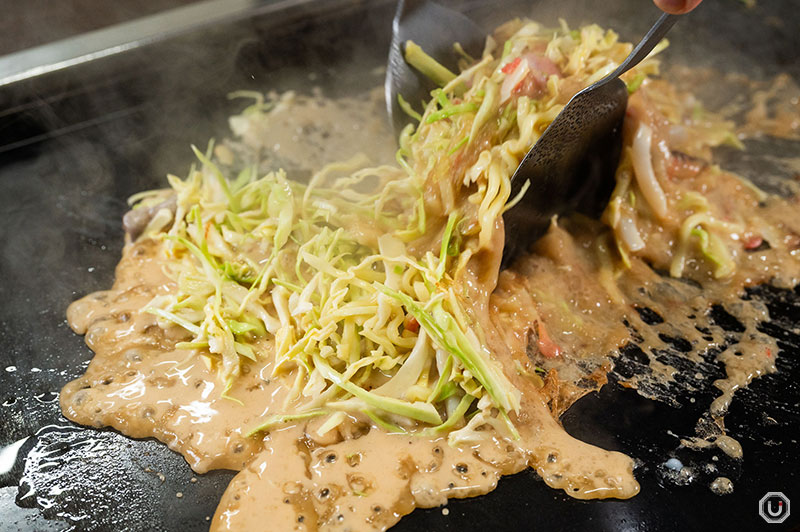
Grilling techniques that vary by restaurant
One key difference between restaurants is how they handle the first step of grilling the ingredients on the oiled griddle.
At Tamatoya, they chop the ingredients finely with spatulas while stir-frying.


We finely chop the cabbage on the hot iron plate to bring out its natural sweetness, and also elevate the umami of the seafood and dashi. Finely chopping the cabbage helps it mix evenly into the batter, and heating it thoroughly draws out moisture and concentrates its flavor.
On the other hand, Yoshimiya’s style is to mix the ingredients immediately without waiting.
The cabbage retains a moderately crunchy texture, adding a crisp bite as an accent.


Since we serve our ingredients already finely chopped, you can mix them with the batter right away. You can eat it immediately or brown the batter a little—it’s totally up to you.
Must-try monjayaki restaurants on Tsukishima Monja Street
With over 50 monjayaki restaurants clustered around Tsukishima Station, Tsukishima Monja Street is the ultimate destination to enjoy this classic Tokyo dish.
Both Yoshimiya and Tamatoya are located on this famous food street.
Yoshimiya: where you can enjoy classic monjayaki

Yoshimiya’s exterior
Established in 1954, Yoshimiya is one of the most long-standing restaurants on Tsukishima Monja Street.
Their monjayaki has been passed down over three generations, preserving a classic, traditional flavor.
The restaurant’s “Special Monjayaki,” made with batter flavored with Worcestershire sauce and ingredients like pork, squid, and noodles, is their most popular dish.

Special Monjayaki at Yoshimiya
Another standout is the “Special Salt Sauce Monjayaki,” featuring a salt-based sauce instead of the usual Worcestershire-style seasoning—something unique to Yoshimiya.
Why not order both and enjoy comparing the rich, savory Special Monjayaki with the light and refreshing Special Salt Sauce Monjayaki?
Tamatoya: seafood monjayaki with creative flair
Opened on Tsukishima Monjayaki Street in 2021, this restaurant leverages its strength as part of a seafood wholesaler established in 1871 — now based at Toyosu Market — to provide seafood-based okonomiyaki. Tamatoya’s exterior Highly recommended is their Squid Ink Monjayaki, made generously with squid ink and fresh squid legs. The combination of squid ink with a clean aftertaste (made possible thanks to its freshness) and the pleasantly chewy texture of the squid tentacles is exquisite. Squid Ink Monjayaki at Tamatoya When mixed well with their seafood-based dashi batter, it creates a refined and creative monjayaki that even pairs well with wine! The ingredients, like the squid and cabbage, release their umami, making each bite incredibly satisfying—it’s sure to leave you completely mesmerized. Umami bites also features other recommended spots on Tsukishima Monjayaki Street, so be sure to check those out too!


